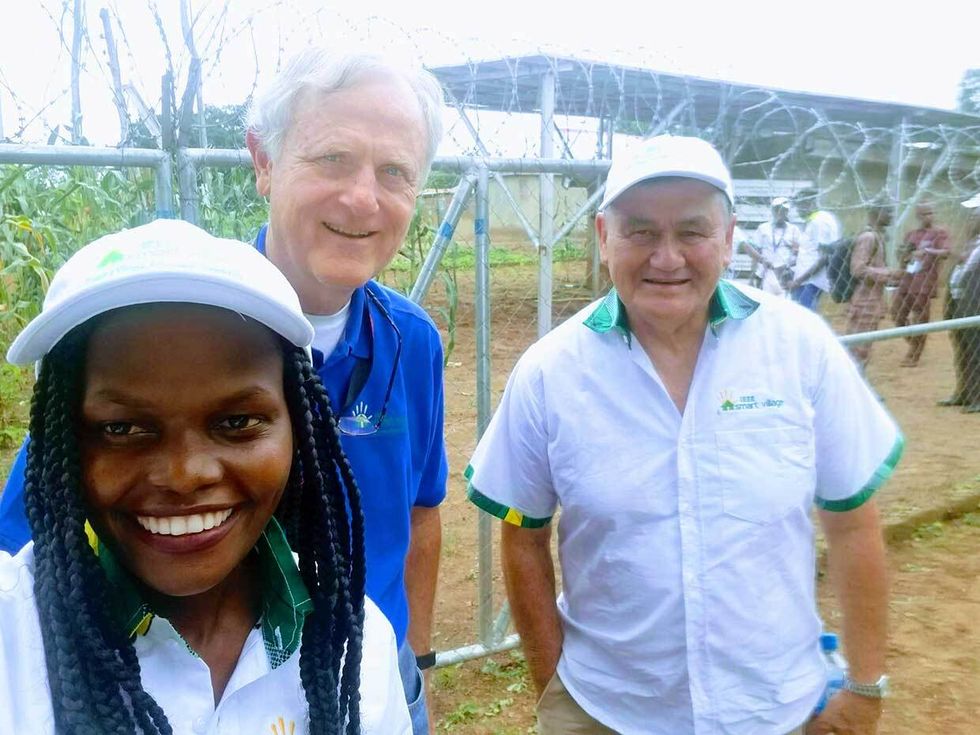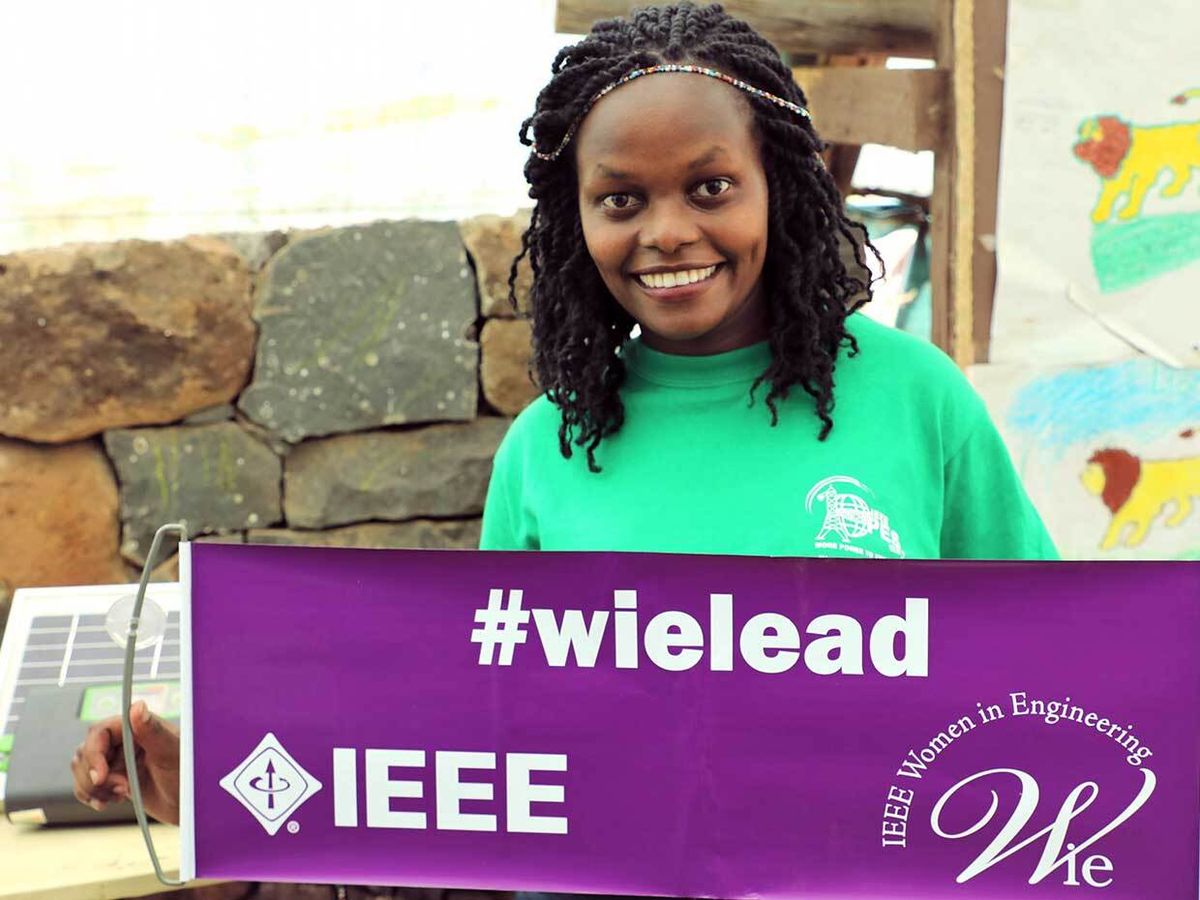Growing up in Sotik, Kenya, Mercy Chelangat saw firsthand how much technology can help underserved communities. When she was young, she and her family visited Nairobi, Kericho, and other Kenyan cities and saw how having reliable electricity could improve lives. It wasn't until 2016 that transmission lines were installed in Sotik, a town in the southern part of the Great Rift Valley ridge. Chelangat's desire to provide the town's homes, stores, and farmers with electricity motivated her to pursue a career in power engineering.
After graduating from college in 2017, she worked for several Kenyan companies striving to provide clean energy to communities around the country. But she felt as though she wasn't leaving a lasting impact on people's lives, so in 2018 she decided to become a full-time volunteer for the IEEE Power & Energy Society's Kenya Chapter. She was the secretary and treasurer and worked to increase membership through social-media outreach.
Through her work for the chapter she learned about IEEE Smart Village, a program that brings electricity—as well as educational and employment opportunities—to remote communities. IEEE Smart Village is one of the donor-supported priority initiatives of the IEEE Foundation. The group asked her to manage an electrification project inside Kenya's Maasai Mara National Reserve, where she assessed communities' needs.
For the project, Smart Village partnered with the Maa Trust, a nonprofit that aims to combine education, technology, and vocational training to enhance opportunities for children in Maasai Mara.
After completing her assignment last year, Chelangat joined Smart Village, where she is responsible for pursuing funding opportunities.
She hasn't left hands-on power-engineering work behind, however. She is helping to provide electricity and Internet connectivity to telehealth centers in Kenya so doctors can interact with patients who live in remote areas. The project is in partnership with IEEE Smart Village, the Rotary eClub of Silicon Valley, the Global Telehealth Network, and Rotary International.
For her humanitarian efforts, Chelangat received the 2019 IEEE Region8 Women in Engineering Clementina Saduwa Award. The honor recognizes female engineers who, through their engineering and career achievements, have demonstrated support for women in the profession and have established a record of excellence. It was named after IEEE Member Clementina Saduwa, who was killed at age 29 in 2007 in a random act of violence.
“Volunteering through IEEE has expanded my mind and has allowed me to meet people from different walks of life," Chelangat says.
PURSUING HER PASSION
After earning a bachelor's degree in electrical and electronics engineering from Moi University, in Eldoret, Kenya, Chelangat became a researcher for Industrial Promotion Services, in Nairobi. IPS focuses on providing farmers and rural communities with affordable energy.
Chelangat and her team were assessing if they could use solar-powered mini electrical grids. But the organization didn't find the projects feasible at the time, as there was little demand for power in the communities, Chelangat says.
She says she felt as though she wasn't using her engineering skills there, so she left in 2018 to become a trainee at OFGEN, an engineering, procurement, and construction company in Nairobi.
She learned more hands-on technical skills in solar power, smart metering, and power storage solutions. But she felt discouraged after a project manager would not let her install solar panels. She says he was concerned that, as a woman, she couldn't handle the equipment and might hurt herself.
Chelangat says she felt she was being discriminated against, and she decided to leave the company to volunteer full time for the IEEE PES Kenya Chapter.
“Leaving the company was quite difficult, but I don't regret it, because it was through my volunteer work that I was able to meet Robin Podmore," she says. Podmore, an IEEE life Fellow and cofounder of IEEE Smart Village, became her mentor.

The two met when he visited Nairobi to train systems operators and engineers for Smart Village projects. After the training session, Chelangat approached Podmore about some of her ideas on bringing power to underserved communities in Kenya.
He offered her an internship with Smart Village as the manager of a project in the Maasai Mara National Reserve.
Chelangat spent six months in the reserve assessing electrification, hardware, and networking needs for homes, schools, and businesses. She found that the schools needed electrification and Internet access.
The solar panels the program installed at the Maa Trust headquarters not only powered staff houses and businesses but also the school's new vocational IT hub. The trust plans to use the hub—built by engineers and locals—to train teachers how to use technology in the classroom.
The vehicles the villagers drove were used mainly to transport tourists around the reserve. The vehicles also transported goods. But the trucks relied on diesel fuel, which was costly. In order to reduce air pollution and costs, volunteers are researching which electric vehicles could be comfortably driven on the rough terrain. Electric trucks could be charged by the microgrid the engineers installed.
Chelangat continues to volunteer for humanitarian efforts in Kenya.
“Mercy is highly motivated and passionate about IEEE Smart Village and IEEE," Podmore says. “There is still a huge amount of work to be done, but Mercy has all the right stuff to succeed."
Chelangat is working remotely on a project to help Kenyan telehealth centers solve Internet connectivity and power challenges during the COVID-19 pandemic. As of 28 March, Kenya had more than 130,000 confirmed coronavirus cases and more than 2,100 deaths, according to the U.S.Embassy inKenya.
ACTIVE VOLUNTEER
Chelangat joined IEEE in 2017 as a student member after her friend, IEEE Member Kithinji Muriungi, introduced her to the organization.
A year after joining, Chelangat and a few other IEEE members founded the IEEE PES chapter. She became its secretary and treasurer and was able to travel to conferences and meet members from around the world. She attended the 2018 PES Student Congress in Brazil—which, she says, helped her make more connections. She calls such experiences “networking without borders."
As the IEEE Region8 lead for the IEEE PES Women in Power group, Chelangat works to increase its membership. The group aims to get more women into the power industry, and it works to promote women to leadership positions.
“I'm passionate about empowering women engineers," she says. “There are so many challenges we face, so I took up this role to try and also give women in Region8 credibility and a community."
IEEE membership offers a wide range of benefits and opportunities for those who share a common interest in technology. If you are not already a member, consider joining IEEE and becoming part of a worldwide network of more than 400,000 students and professionals.
- How 14 Microgrids Set Off a Chain Reaction in A Himalayan Village - IEEE Spectrum ›
- Africa’s Electricity-Access Problem Is Worse Than You Think - IEEE Spectrum ›
- IEEE Society Restores Electricity To a Nepali School - IEEE Spectrum ›
- This Rwandan Engineer is Learning How to Manage Humanitarian Projects - IEEE Spectrum ›
- From Cleaning Offices to Designing EV Charging Stations - IEEE Spectrum ›
- This Nigerian Startup’s Minigrid Began as a School Project - IEEE Spectrum ›
- This Lockheed Martin Researcher’s Work on UAVs Saves Lives - IEEE Spectrum ›
Joanna Goodrich is the associate editor of The Institute, covering the work and accomplishments of IEEE members and IEEE and technology-related events. She has a master's degree in health communications from Rutgers University, in New Brunswick, N.J.



